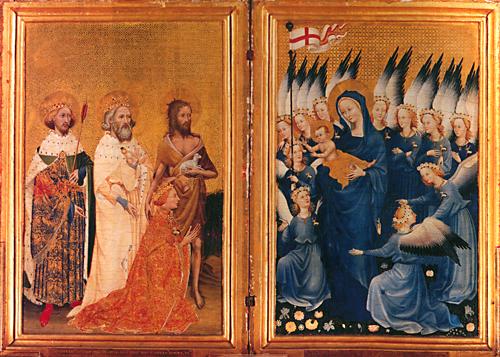
1395
Tempera on oak panel, 36.8 x 26.7 cm
National Gallery, London

1395
Tempera on oak panel, 36.8 x 26.7 cm
National Gallery, London
The Wilton Diptych (named after the house in which it was preserved) is the finest work in England in the International Gothic style. Although it is a painting of extraordinary beauty and must be from the hand of an artist of the highest rank, critics disagree as to whether he was English, French or Italian.
St Edmund, king and martyr, St Edward the Confessor and St John the Baptist present the kneeling monarch Richard II of England in the left panel to the azure assembly of the Virgin and Child, attended by angels, on the right panel. The left scene is set in an earthly forest, the right in the flowering garden of heaven.
The monarch wears around his neck the white hart badge which Richard adopted in 1390 as his personal insignia. It reappears on the reverse of the left panel. Both it and the French insignia of broom-cods (seed-pods) are woven into the king's iridescent gold mantle. The white hart badge is also worn by each of the eleven angels, who thus become royal retainers. One of them holds the banner of St George (the English national saint).
The event commemorated here has been conjectured as Richard's coronation in 1377, his seeking divine sanction for a crusade in the mid-1990s, or his meeting with the French king in 1396.
Click on the links to see close-ups of the left panel and right panel.